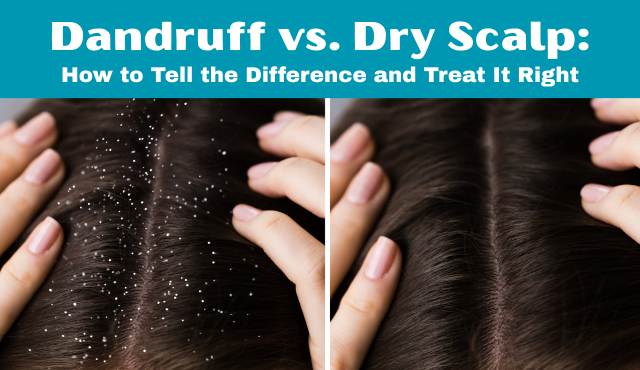
You’re scratching your head again—annoyed, maybe even a little embarrassed. Is it dandruff? Or just a dry scalp acting up? Don’t worry, you’re not alone! So many of us confuse the two because they look so similar: flakes, itchiness, discomfort. But here’s the deal—dandruff and dry scalp are totally different issues, and treating them the same way might actually make things worse.
That’s why understanding the difference is the first step toward finding real relief. In this blog, we’re breaking it down in the simplest way possible: what causes each condition, how to spot the signs, and most importantly, how to treat them right. Whether you’re tired of flaky shirts or just want to give your scalp the TLC it deserves, you’ll find practical tips and product suggestions that actually work. Let’s clear things up—literally and figuratively. Ready to know what’s really going on up there? Let’s dive in!
Best Ways to Treat Dandruff: Medicated Shampoos, Home Remedies, and Lifestyle Changes
Dandruff can be frustrating—those pesky white flakes, itchy scalp, and constant discomfort. The good news? It’s totally manageable with the right combination of treatments and lifestyle changes. Here’s a step-by-step guide to help you get rid of dandruff and keep your scalp healthy and flake-free.
Step 1: Choose the Right Medicated Anti-Dandruff Shampoo
Start by picking a shampoo that’s specifically formulated to fight dandruff. Look for active ingredients like:
- Zinc pyrithione – fights the yeast that causes dandruff
- Ketoconazole – an antifungal that treats more stubborn cases
- Selenium sulfide – slows skin cell turnover and reduces flaking
- Coal tar – helps reduce skin cell shedding
- Salicylic acid – breaks down flakes and cleanses the scalp
Use the shampoo 2–3 times a week, and leave it on your scalp for a few minutes before rinsing so it can work its magic.
Step 2: Exfoliate Your Scalp to Remove Dead Skin and Oil
Just like your face, your scalp needs exfoliation too! This helps remove buildup, dead skin, and excess oil that can trigger dandruff. Use a gentle scalp scrub or a soft scalp brush once or twice a week.
You can also try DIY scalp exfoliation with brown sugar and coconut oil—mix the two and massage gently into your scalp before shampooing. This keeps your scalp clean and boosts blood circulation.
Step 3: Apply Natural Home Remedies to Reduce Dandruff Naturally
If you’re looking for natural options, several home remedies can soothe your scalp and fight dandruff:
- Tea tree oil – Add a few drops to your shampoo. Its antifungal properties are great for dandruff.
- Aloe vera gel – Soothes itchiness and hydrates dry scalp.
- Apple cider vinegar – Mix with water and use as a scalp rinse to balance pH and reduce flakes.
- Yogurt and lemon – A natural mask that hydrates and clears dandruff-causing bacteria.
These remedies are best used 1–2 times a week alongside your regular hair care routine.
Step 4: Adjust Your Diet to Support Scalp Health
What you eat plays a big role in your scalp’s health. A poor diet can trigger inflammation and dryness, worsening dandruff. Try to include:
- Omega-3 fatty acids (like in walnuts, flaxseeds, and salmon) to hydrate skin from within
- Zinc-rich foods like pumpkin seeds, chickpeas, and eggs
- Biotin and B vitamins from leafy greens, eggs, and whole grains
- Probiotics to maintain healthy gut flora, which can impact skin and scalp
Drink enough water daily to keep your skin hydrated and healthy from the inside out.
Step 5: Reduce Stress to Prevent Dandruff Flare-Ups
Stress doesn’t cause dandruff directly, but it can worsen it by affecting your immune system and increasing oil production on the scalp. Try these stress-reducing habits:
- Practice meditation or deep breathing exercises
- Engage in regular physical activity like walking or yoga
- Make time for hobbies and quality sleep
- Set boundaries and take mental health breaks when needed
A relaxed mind often leads to a calmer scalp.
Step 6: Maintain a Consistent Hair Care Routine
Consistency is key. Even the best treatments won’t work if you don’t stick to them. Here’s what a healthy routine looks like:
- Wash your hair regularly (every 2–3 days) with your anti-dandruff shampoo
- Don’t overuse styling products—they can build up on your scalp
- Avoid harsh treatments like excessive heat styling or chemical treatments
- Dry your hair properly and avoid sleeping with wet hair
Listen to your scalp—it’ll tell you when it needs a little extra care.
Conclusion:
Treating dandruff isn’t just about picking the right shampoo—it’s about caring for your scalp with a complete approach. By combining medicated treatments, gentle natural remedies, and positive lifestyle changes, you can say goodbye to flakes and hello to a healthier, happier scalp. Stick to the routine, be patient, and your scalp will thank you.
At Reviera Overseas, we’re passionate about helping brands create effective, high-quality personal care products—including anti-dandruff solutions that actually work. If you’re looking to launch your own line of hair care products or need expert private label manufacturing, we’re here to support you with custom formulations and skin-friendly ingredients.